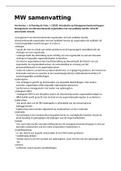MW samenvatting
Van Harten, J. & Penning de Vries, J. (2023). Introductie op Managementwetenschappen:
Management van dienstverlenende organisaties met een publieke functie. Utrecht:
Universiteit Utrecht.
-management van dienstverlenende organisaties met een publieke functie
-dienstverlenende organisaties met een publieke functie als organisaties die publieke (of
maatschappelijke) waarde beogen te creëren.
-strategie:
*vanuit de visie en missie van veelal oprichters en/of topmanagers ontwikkelt zich de
strategie van een organisatie.
*strategie heeft dus betrekking op de richting van een organisatie en wel een bewuste
richting om bepaalde organisatiedoelen te bereiken
*de interne organisatiecontext heeft betrekking op bijvoorbeeld de historie van een
organisatie, de organisatiestructuur, de samenstelling en omvang van het
personeelsbestand en de organisatiecultuur
*onder de externe context kun je bijvoorbeeld wet- en regelgeving plaatsen, de invloed van
heersende normen en waarden in de maatschappij (dit zijn institutionele krachten) of
maatschappelijke ontwikkelingen
-opbrengsten:
*een strategie is gericht op het bereiken van bepaalde doelstellingen. Met andere
woorden, organisaties willen bepaalde opbrengsten genereren
*performance management= het meten van opbrengsten
-strategisch HRM:
*strategisch HRM is een discipline waarin de afstemming tussen organisatiestrategie en
HRM-beleid wordt gezocht met als doel om de organisatieopbrengsten te verbeteren
-leiderschap:
*een groot deel van de HR-maatregelen is afhankelijk van de uitvoering door
leidinggevenden
*leiderschap moet worden afgestemd op medewerkers en hun motivatie
-motivatie:
*de bedoeling is dat medewerkers bepaalde kennis en vaardigheden bezitten alsook de
juiste houding en gedragingen die bijdragen aan de organisatiedoelen
-welzijn:
*een veel onderzochte veronderstelling binnen de managementwetenschappen is dat een
tevreden medewerker ook een meer productieve medewerker is
-modelbeperking:
*er zijn slechts een beperkt aantal pijlen in het MW-model getekend
*modelmatig denken
*welzijn staat nu als een oorzaak van opbrengsten, maar het kan ook een opbrengst zelf
zijn
-context:
*reflecteer vanuit actuele ontwikkelingen
,Rainey, H. (2014). What makes public organizations distinctive. In: Rainey, H. (2014).
Understanding and managing public organizations, 53-85. John Wiley and Sons.
-the commonsense observation that an organization becomes bureaucratic not because it is
in government or business but because of its large size
-blurring of the sectors:
*a diverse array of state-owned enterprises, government corporations, government-
sponsored corporations, and public authorities perform crucial functions
*organizations are sometimes the subjects of controversy over whether they operate in a
sufficiently businesslike fashion while showing sufficient public accountability. These
hybrid arrangements often involve massive financial resources
*finally, many private, for-profit organizations work with government in ways that blur the
distinction between them. Some corporations, such as defense contractors, receive so
much funding and direction from government that some analysts equate them with
government bureaus
-complex interrelations:
*governments buy products and services from nongovernmental organizations
*governments provide services, such as healthcare etc.
*these entangled relations muddle the question of where government and the private
sector begin and end
-according to some critics, government agencies also sometimes behave too much like
private organizations
-one of the foremost contemporary criticisms of government concerns the influence that
interest groups wield over public agencies and programs
-the increase in privatization and contracting out has led to increasing controversy over
whether privatization proponents have made oversimplified claims about the benefits of
privatization
-clear demarcations between the public and private sectors are impossible, and
oversimplified distinctions between public and private organizations are misleading
-distinctions:
*private managers earn way more than public managers
-polyarchy= political hierarchy (hydra-headed hierarchy)
*draws on political authority (social control)
-markets have a limited capacity to handle the types of problems for which government
action is required:
*free riders (taxes imposed)
*individual incompetence (government regulates activities)
*externalities (negative external effects, monopolies etc.)
-in spite of the blurring of the distinction between the public and private sectors,
government organizations in the United States and many other nations remain restricted to
certain functions. For the most part, they provide services that are not exchanged on
economic markets but are justified on the basis of general social values, the public interest,
and the politically imposed demands of groups
-public values
*public value consists of what governmental activities produce, with due authorization
through representative government, and taking into consideration the efficiency and
effectiveness with which the public outputs are produced
, *public managers create public value when they produce outputs for which citizens express
a desire (can create in two ways):
>deploy the money and authority entrusted to them to produce things of value to
particular clients and beneficiaries
>establishing and operating an institution that meets citizens’ (and their representatives’)
desires for properly ordered and productive public institutions
>Moore offered no explicit definition of “public value” except that it derives from citizen
desires
-Accenture Public Value Model:
*the authors of the model explain that public value emerges from the production of
outcomes of governmental activities, considered together with the cost-effectiveness of
producing those outcomes
*“Outcomes” are a weighted basket of social achievements
*“Cost-effectiveness” is defined as annual expenditure minus capital expenditure, plus
capital charge
-Bozeman
*a society’s ‘public values’ are those providing normative consensus about:
>the rights, benefits, and prerogatives to which citizens should (and should not) be
entitled
>the obligations of citizens to society, the state, and one another
>the principles on which governments and policies should be based
* individual public values:
>the content-specific preferences of individuals concerning, on the one hand, the rights,
obligations, and benefits to which citizens are entitled and, on the other hand, the
obligations expected of citizens and their designated representatives
-Bozeman at certain points emphasizes public value “failure,” when neither the market nor
the public sector provides goods and services that achieve public values. Moore emphasized
positive production of outcomes that enhance public value, but, by implication, failure to
produce such outcomes fails to create or increase public value
-the distinction between public and private often involves three major factors:
*interests affected (whether benefits or losses are communal or restricted to individuals)
*access to facilities, resources, or information
*agency (whether a person or organization acts as an individual or for the community as a
whole)





